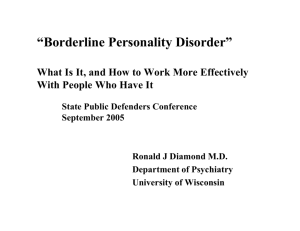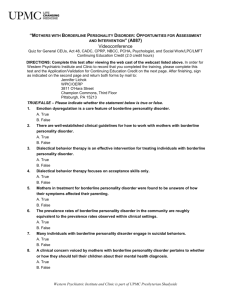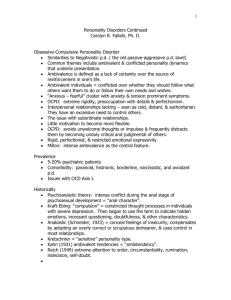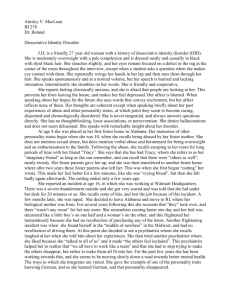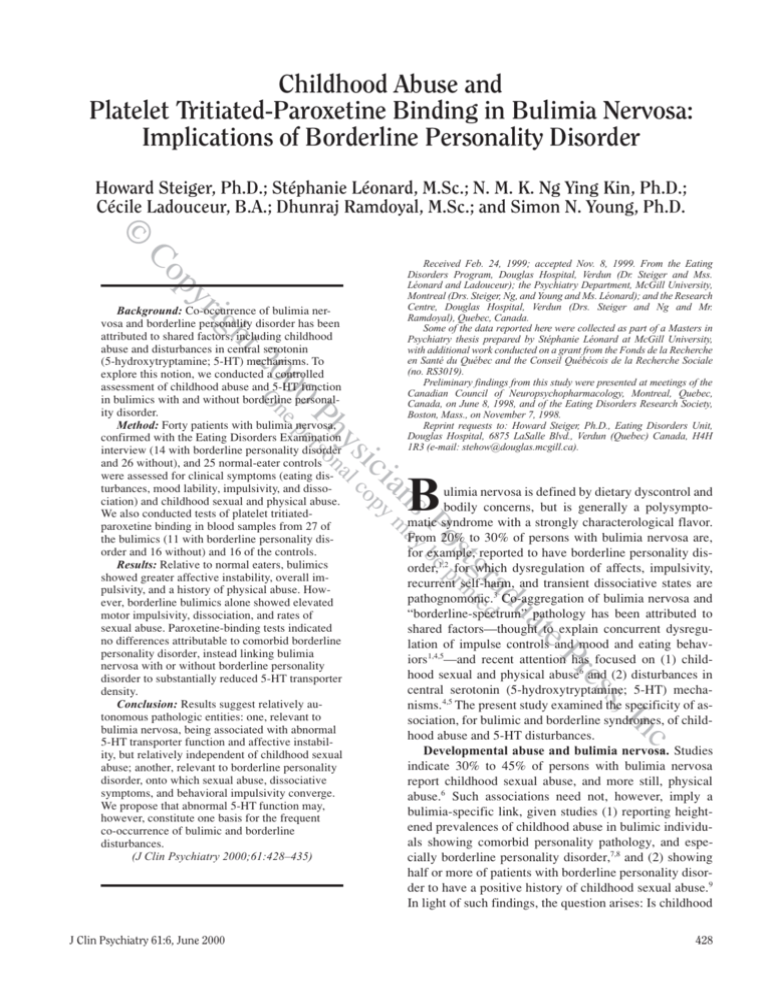
Abuse and Paroxetine Binding in Bulimia
Childhood Abuse and
Platelet Tritiated-Paroxetine Binding in Bulimia Nervosa:
Implications of Borderline Personality Disorder
Howard Steiger, Ph.D.; Stéphanie Léonard, M.Sc.; N. M. K. Ng Ying Kin, Ph.D.;
Cécile Ladouceur, B.A.; Dhunraj Ramdoyal, M.Sc.; and Simon N. Young, Ph.D.
©
r
py
Co
ht
ig
Background: Co-occurrence of bulimia nervosa and borderline personality disorder has been
attributed to shared factors, including childhood
abuse and disturbances in central serotonin
(5-hydroxytryptamine; 5-HT) mechanisms. To
explore this notion, we conducted a controlled
assessment of childhood abuse and 5-HT function
in bulimics with and without borderline personality disorder.
Method: Forty patients with bulimia nervosa,
confirmed with the Eating Disorders Examination
interview (14 with borderline personality disorder
and 26 without), and 25 normal-eater controls
were assessed for clinical symptoms (eating disturbances, mood lability, impulsivity, and dissociation) and childhood sexual and physical abuse.
We also conducted tests of platelet tritiatedparoxetine binding in blood samples from 27 of
the bulimics (11 with borderline personality disorder and 16 without) and 16 of the controls.
Results: Relative to normal eaters, bulimics
showed greater affective instability, overall impulsivity, and a history of physical abuse. However, borderline bulimics alone showed elevated
motor impulsivity, dissociation, and rates of
sexual abuse. Paroxetine-binding tests indicated
no differences attributable to comorbid borderline
personality disorder, instead linking bulimia
nervosa with or without borderline personality
disorder to substantially reduced 5-HT transporter
density.
Conclusion: Results suggest relatively autonomous pathologic entities: one, relevant to
bulimia nervosa, being associated with abnormal
5-HT transporter function and affective instability, but relatively independent of childhood sexual
abuse; another, relevant to borderline personality
disorder, onto which sexual abuse, dissociative
symptoms, and behavioral impulsivity converge.
We propose that abnormal 5-HT function may,
however, constitute one basis for the frequent
co-occurrence of bulimic and borderline
disturbances.
(J Clin Psychiatry 2000;61:428–435)
O
a
du
ra ted
stgprin
Po be
ns ay
ia y m
ic op
ys nal c
Pherso
00 ne p
20
Received Feb. 24, 1999; accepted Nov. 8, 1999. From the Eating
Disorders Program, Douglas Hospital, Verdun (Dr. Steiger and Mss.
Léonard and Ladouceur); the Psychiatry Department, McGill University,
Montreal (Drs. Steiger, Ng, and Young and Ms. Léonard); and the Research
Centre, Douglas Hospital, Verdun (Drs. Steiger and Ng and Mr.
Ramdoyal), Quebec, Canada.
Some of the data reported here were collected as part of a Masters in
Psychiatry thesis prepared by Stéphanie Léonard at McGill University,
with additional work conducted on a grant from the Fonds de la Recherche
en Santé du Québec and the Conseil Québécois de la Recherche Sociale
(no. RS3019).
Preliminary findings from this study were presented at meetings of the
Canadian Council of Neuropsychopharmacology, Montreal, Quebec,
Canada, on June 8, 1998, and of the Eating Disorders Research Society,
Boston, Mass., on November 7, 1998.
Reprint requests to: Howard Steiger, Ph.D., Eating Disorders Unit,
Douglas Hospital, 6875 LaSalle Blvd., Verdun (Quebec) Canada, H4H
1R3 (e-mail: stehow@douglas.mcgill.ca).
ulimia nervosa is defined by dietary dyscontrol and
bodily concerns, but is generally a polysymptomatic syndrome with a strongly characterological flavor.
From 20% to 30% of persons with bulimia nervosa are,
for example, reported to have borderline personality disorder,1,2 for which dysregulation of affects, impulsivity,
recurrent self-harm, and transient dissociative states are
pathognomonic.3 Co-aggregation of bulimia nervosa and
“borderline-spectrum” pathology has been attributed to
shared factors—thought to explain concurrent dysregulation of impulse controls and mood and eating behaviors 1,4,5—and recent attention has focused on (1) childhood sexual and physical abuse6 and (2) disturbances in
central serotonin (5-hydroxytryptamine; 5-HT) mechanisms. 4,5 The present study examined the specificity of association, for bulimic and borderline syndromes, of childhood abuse and 5-HT disturbances.
Developmental abuse and bulimia nervosa. Studies
indicate 30% to 45% of persons with bulimia nervosa
report childhood sexual abuse, and more still, physical
abuse.6 Such associations need not, however, imply a
bulimia-specific link, given studies (1) reporting heightened prevalences of childhood abuse in bulimic individuals showing comorbid personality pathology, and especially borderline personality disorder,7,8 and (2) showing
half or more of patients with borderline personality disorder to have a positive history of childhood sexual abuse.9
In light of such findings, the question arises: Is childhood
te
s,
es
Pr
In
c.
J Clin Psychiatry 61:6, June 2000
B
429
428
Steiger et al.
©
abuse associated with bulimia nervosa, or with borderline
personality disorder found in only some bulimic patients?
The present study addressed this question.
Serotonin dysfunction and bulimia nervosa. Evidence shows 5-HT to moderate mood, impulsive behavior,
and satiety, 4,5 and this creates a rationale for the hypothesis
that central 5-HT mechanisms act in the predisposition to
(or perpetuation of) bulimia nervosa. Empirical support
for this notion has been impressive. Jimerson et al.10 found
high-frequency binge eaters (in a normal-weight bulimic
sample) to have significantly lower levels of 5-HT metabolites in cerebrospinal fluid than did low-frequency
binge eaters or controls. Goldbloom et al.11 reported 22 active bulimics to have higher platelet 5-HT uptake rates
than did 20 age-matched controls, and interpreted this to
imply an adaptation to reduced 5-HT. Similarly, several
studies in bulimia nervosa have documented blunted prolactin responses to 5-HT agonists or partial agonists4 (implying down-regulation at postsynaptic 5-HT sites). Finally, the selective serotonin reuptake inhibitor (SSRI)
fluoxetine is found to yield clinically significant reductions in binge-eating episodes.12 While such findings indicate association between bulimia nervosa and 5-HT
anomalies, they need not imply bulimia-specific effects.
Compared with healthy controls, patients with borderline
personality disorder also show signs of decreased 5-HT
tone, or anomalous hormonal responses to 5-HT agonists,9
and clinical trials show fluoxetine to be effective in treatment of dysphoria, impulsivity, and self-mutilation in
some patients who have this disorder.13 The possibility exists, therefore, that “borderline” phenomena may account
for some aspects of the 5-HT anomalies observed in bulimia nervosa. Our study also addressed this second issue.
Limited data are available that bear upon the implications of borderline features for 5-HT function in bulimia
nervosa: Verkes and colleagues14 found bulimics with borderline personality disorder (N = 5) to show elevated
platelet 5-HT content relative to bulimics without borderline personality disorder (N = 10) and argued that this
might reflect increased uptake associated with reduced
circulating 5-HT. Likewise, Waller and colleagues15 noted
self-reportedly impulsive bulimics in a small (N = 6)
sample to show greater blunting of prolactin responses
following buspirone treatment (which they presumed to
be largely a 5-HT 1A agonist).
The present study. A first goal in this study was to determine whether bulimics with and without borderline personality disorder spanned a continuum of disturbances
(with respect to psychiatric symptomatology, childhood
abuse, and 5-HT function) or showed distinct areas of disturbance (as might suggest distinct psychopathologic
spectra). Another goal of this study was to allow an exploration into the association between abuse history and
5-HT function. We assessed borderline personality disorder, childhood abuse, and eating symptoms by structured
r
py
Co
ht
ig
O
a
du
ra ted
stgprin
Po be
ns ay
ia y m
ic op
ys nal c
Pherso
00 ne p
20
interview, and concurrent psychiatric symptoms (affective
instability, impulsivity, and dissociation) by questionnaire. Serotonin function was assessed by measuring binding, in blood platelets, of the selective 5-HT reuptake inhibitor [3H]-paroxetine.
There are various reasons for the assumption that platelet paroxetine binding models central 5-HT transporter
(or reuptake) mechanisms16,17: (1) Platelets possess high affinity-uptake sites for 5-HT, which seem morphologically
and kinetically comparable with 5-HT reuptake sites in
brain.16,17 (2) Platelet binding is selectively associated with
binding in brain tissue.16 (3) Antidepressant response in
depressed outpatients coincides with normalization of 5-HT
reuptake inhibitor binding in the periphery.18 (4) Platelet
paroxetine binding has been applied as a model of 5-HT
function in various clinical syndromes.19,20 While ours is (to
our knowledge) the first application of paroxetine binding
in bulimia nervosa, Marazziti and colleagues21 have used
platelet imipramine binding as a model of 5-HT function
and found transporter density (Bmax), but not affinity (K d),
to be reduced in bulimic versus nonbulimic women.
Participants
Bulimic group. Forty women with bulimia nervosa
were recruited through a specialized outpatient service.
Eating-disorder status was confirmed at the start of the
study using the Eating Disorders Examination (EDE) interview.22 On the basis of the EDE, 33 (82.5%) women
met Diagnostic and Statistical Manual for Mental Disorders, Fourth Edition (DSM-IV)3 criteria for bulimia nervosa, purging subtype; 1 (2.5%) for bulimia nervosa,
nonpurging subtype; and 4 (10.0%) for a subclinical
bulimia nervosa purge type (bingeing once versus the
requisite twice weekly). According to interviews, our bulimic participants binged on a mean ± SD of 16.96 ± 7.03
days monthly at a frequency of 24.55 ± 14.35 episodes
monthly. Those who vomited did so on a mean of
16.74 ± 9.95 days monthly, at a mean frequency of
47.17 ± 50.80 times monthly. Mean ± SD age and body
mass index (BMI) in this sample were 26.30 ± 6.19 years
and 22.01 ± 3.48 kg/m2, respectively.
Normal-eater control. Members of the normal-eater
control group (N = 25) were recruited through advertisements or university classes and were admitted to the study
if they had no past or present eating disorder upon interview and no overt psychiatric history upon inquiry. All denied bingeing, purging, or use of psychoactive medications. Mean ± SD age and BMI in this group were
20.80 ± 3.69 years and 20.72 ± 1.85 kg/m2, respectively.
te
s,
es
Pr
In
c.
430
429
METHOD
Measures
Rating scales. Well-known interviews and questionnaires were selected for demonstrated psychometric
J Clin Psychiatry 61:6, June 2000
Abuse and Paroxetine Binding in Bulimia
©
strengths and relevance to constructs of interest. We
used the EDE22 interview and the Eating Attitudes Test
(EAT-26)23 to tap clinical eating-disorder symptoms and
BMI to reflect nutritional status. We also measured personality disorders using the Structured Clinical Interview
for DSM-IV Axis II (SCID-II),24 which we used to classify all patients as either having or not having borderline
personality disorder. The borderline personality disorder
criterion referring to overeating was excluded. Interrater
reliability checks on a subsample of 17 interviews (selected pseudorandomly to represent adequate numbers of
probable “borderline” and “nonborderline” diagnoses)
yielded a kappa of 0.68 (representing 88.2% agreement)
for a borderline/nonborderline distinction.
Additional psychopathologic characteristics were evaluated using the Dissociative Experiences Scale (DES)25; the
Barrat Impulsivity Scale (BIS; version 10),26 producing
scores measuring cognitive, motor, and nonplanning impulsivity; and the affective instability subscale from the Dimensional Assessment for Personality Pathology-Basic
Questionnaire (DAPP-BQ).27 Finally, to assess childhood
abuse, we used the Childhood Trauma Interview (CTI).28
We used CTI severity and age indices to isolate experiences
involving frankly inappropriate sexual or physical contacts
occurring prior to age 13 years and then up to age 18 years.
Given a bilingual population, we employed official, validated French translations of the DES and EAT-26 and developed French translations for other scales using careful
forward and back translation techniques. On global indices, translations were psychometrically equivalent to corresponding English questionnaires.
Paroxetine binding. Blood samples were always drawn
between 8:30 and 9:00 a.m., after an overnight fast. Participants were asked to refrain from alcohol or nonprescription drug use for 48 hours prior to testing and from
binge eating for 24 hours prior to testing. Whole blood was
collected in Vacutainer tubes containing the anticoagulant
EDTA and kept on ice (for no more than 30 minutes) until
platelets were isolated by differential centrifugation. Platelet rich plasma was first isolated at 280g for 15 min at 4°C.
Platelets were then isolated from the platelet rich plasma
at 18,000g for 15 min. Next, the pellets were washed in
buffer containing EDTA/Tris/NaCl, pH 7.5, and homogenized using a Polytron (Brinkman Instruments, Roxdale,
Ontario, Canada). The lysed membranes were stored in a
small volume of buffer at –80°C until analyzed. Blood
work was done under blind conditions. The binding experiment was performed as described by Langer et al.29
Lysed membranes (0.8 to 2.0 mg protein) were incubated
in a Tris/EDTA/NaCl/KCl buffer containing 0.05 to 10 nM
of [3H]-paroxetine (26.5 Ci/mmol [980.5 GBq], NEN [Life
Science Products, Boston, Mass.]) for 90 min at 20°C. The
bound and free ligands were separated by filtration on
GF/B Whatman filters, washed 3 times with buffer, and
counted. Specific binding, determined by incubating
[3H]-paroxetine in the presence and absence of an excess
amount of citalopram (3 µM), was found to be between
70% to 90% of total binding. The apparent Bmax and Kd
were obtained by Scatchard analysis of binding curves for
the different concentrations of [ 3H]-paroxetine.
r
py
Co
ht
ig
O
s,
es
Pr
In
c.
J Clin Psychiatry 61:6, June 2000
te
a
du
ra ted
stgprin
Po be
ns ay
ia y m
ic op
ys nal c
Pherso
00 ne p
20
Procedure
All participants provided written informed consent
for research. Measures of psychopathology and childhood abuse were obtained from all participants, and
blood samples from a subset of 27 bulimics (11 with borderline personality disorder [BN/BPD] and 16 without
[BN/nonBPD]) and 16 normal-eater control (NC) participants. The 5-HT indices thus represented diagnostic classifications well. Potential sources of extraneous variation
on 5-HT measures necessitate controls or comment:
(1) Contraceptive use: Given reports suggesting absence
of marked effects of oral contraceptives on blood 5-HT
indices, 30 we did not treat contraceptive use as an exclusion criterion. We did, however, test for differences (on
paroxetine-binding indices) among individuals who were
or were not taking contraceptives and found no significant
effects. (2) Seasonal effects: Seasonal variations have
been observed on various 5-HT indices, with studies in
healthy volunteers reported to yield reduced paroxetine
binding in summer/fall.31 Our recruitment of participants
was skewed over time in such a way that any bias due to
seasonal variations should have run toward reduced binding in normal controls versus bulimics. Nevertheless, we
applied statistical controls for possible confounds due to
seasonal effects, using previously published values31 for
seasonal variations in platelet paroxetine binding (see Results). (3) Menses: To optimize sample size, we combined
one group of participants tested during follicular phase
only with another in whom testing took place on nonmenstrual days. We tested for (and ruled out) potential
confounding effects of menstrual phase on paroxetinebinding findings. (4) Medication: Six cases providing
blood samples (5 BN/BPD and 1 BN/nonBPD) had
started medication (always an SSRI) at the time of recruitment. To optimize sample sizes for data on childhood
abuse, we retained these participants and applied statistical procedures (described below) to rule out confounds
attributable to medication effects. We note, also, that a recent report indicates absence of acute effects of various
antidepressants (including paroxetine) upon platelet paroxetine binding in healthy volunteers.32
RESULTS
Descriptive Data
According to SCID-II criteria, none of our NC participants had borderline personality disorder. A more sizable
number of our bulimic participants met borderline personality disorder criteria (N = 14; 35.0%). When a borderline
431
430
Steiger et al.
©
personality disorder diagnosis was present,
we assigned the participant to the BN/BPD
group, and when not, to the BN/nonBPD
group. Mean ± SD age (26.50 ± 6.25 and
26.20 ± 6.28 years, respectively) did not differentiate BN/BPD from BN/nonBPD
groups. Bulimic participants were, however,
slightly (and significantly) older than were
control participants (F = 7.96, df = 2,62;
p < .01). Where the age variable was correlated with other indices (affective instability,
BIS attention and nonplanning, and Bmax),
findings were confirmed using analyses of
covariance with age as a covariate. BMI
yielded no group differences: mean ± SD values across BN/BPD, BN/nonBPD, and NC
groups were 21.75 ± 3.16, 22.15 ± 3.70, and
20.72 ± 1.85 kg/m2, respectively.
Table 1. Mean ± SD for Borderline-Bulimic (BN/BPD),
Nonborderline-Bulimic (BN/nonBPD), and Normal-Eater Control (NC)
Groups on Indices of Eating and Psychopathologic Symptoms†
Variable
Binge days/mo
Binge episodes/mo
Vomiting days/mo
Vomiting
episodes/mo
BN/BPD
(N = 14)
Mean
SD
19.18
6.52
30.81a 14.45
(N = 13)
17.67
9.96
Group
BN/nonBPD
(N = 26)
Mean
SD
15.77
7.12
21.18b 13.37
(N = 22)
16.18 10.14
63.58a
37.47b 44.04
58.77
NC
(N = 25)
Statistic
Mean
SD t (df = 38)
0.00
0.00 –1.49
0.00
0.00 –2.11*
(N = 25)
t (df = 33)
0.00
0.00 –0.42
0.00
0.00
r
py
Co
–1.50
F
(df = 2,62)
ht
ig
20
(N = 14)
(N = 26)
(N = 25)
Eating Attitudes
Test
39.21a 11.72
36.00a 15.03
4.19b 4.33 65.96**
Dissociation
(DES)
22.73a 14.79
10.95b 11.41
8.47b 4.44
9.12**
Motor impulsivity
a
b
b
(BIS)
27.08
4.36
23.23
3.58
20.76
4.12 11.37**
Cognitive
impulsivity (BIS) 21.68a
2.25
19.54b 2.23
16.28c
2.26 28.61**
Nonplanning
impulsivity (BIS) 27.79
3.74
28.32
4.69
25.26
5.14
2.80
Total impulsivity
(BIS)
76.56a
7.48
71.09a
7.67
62.30b 9.14 14.90**
Affective instability
(DAPP-BQ)
62.66a
9.36
58.58a 13.15
37.86b 12.13 26.54**
†Abbreviations: BIS = Barrat Impulsivity Scale, DAPP-BQ = Dimensional
Assessment for Personality Pathology-Basic Questionnaire, DES = Dissociative
Experiences Scale.
a,b,c
Means with different letters in their superscripts differ at the .05 level or better.
*p < .05.
**p < .001.
O
a
du
ra ted
stgprin
Po be
ns ay
ia y m
ic op
ys nal c
Pherso
00 ne p
Eating Symptoms
Table 1 shows mean ± SD scores for
BN/BPD, BN/nonBPD, and NC groups on
EDE mean monthly binge and vomit indices
(the latter values computed for cases who
were vomiters only) and the EAT-26. Results
of t tests revealed significant borderline/
nonborderline differences on mean monthly
binge episodes, borderline patients showing
the higher frequencies. No corresponding differences were obtained on measures of mean
days of bingeing or vomiting per month, or of mean vomiting episodes per month. On EAT-26 scores, analysis of
variance (ANOVA) revealed a significant group effect (see
Table 1), Newman-Keuls tests indicating reliable bulimic
versus nonbulimic differences but no borderline/nonborderline differences.
s,
es
Pr
In
c.
432
431
Childhood Abuse
Table 2 shows numbers (and proportions) of participants in each group who reported sexual abuse, physical
abuse, or any abuse (i.e., either form of abuse), both before age 13 years and up to age 18 years. Group effects
(or trends) were obtained for data reflecting sexual abuse
prior to age 13 (χ2 = 5.22, df = 2, p < .08) and up to age
18 (χ2 = 10.22, df = 2, p < .01). Pairwise group comparisons for prevalences prior to age 13 were (given low frequencies in some cells) conducted using Fisher exact
tests, and a significant difference was obtained between
BN/BPD and NC groups (p < .03) alone. Hence, elevated
childhood sexual abuse seemed to be characteristic
largely of BN/BPD cases and only nonsignificantly elevated among BN/nonBPD bulimics.
To further explore an apparent association between
sexual abuse and borderline personality disorder, we conducted an analysis to reflect associations between each
diagnostic classification and type of abuse, computing
proportions of cases in each group who reported
te
Psychiatric Symptoms
Table 1 also provides mean ± SD results for BN/BPD,
BN/nonBPD, and NC groups on measures of dissociation
(total score), impulsivity (motor, cognitive, nonplanning,
and total scores), and affective instability (total score).
One-way multivariate ANOVA on the total dissociation,
impulsivity, and affective instability scores yielded an
omnibus group effect (Wilks lambda = 11.07, df = 6,120;
p < .001), and we therefore proceeded to univariate
ANOVAs. Reliable univariate group effects were obtained
on all but the nonplanning impulsivity variable (see Table
1); those on affective instability (F = 20.80, df = 2,61;
p < .001) and cognitive impulsivity (F = 24.18, df = 2,61;
p < .001) remained after age effects were removed
through analyses of covariance (ANCOVAs). Nonsignificant results on nonplanning impulsivity were unchanged
when age effects were removed through ANCOVAs.
Group comparisons (Newman-Keuls) showed the follow-
ing: on dissociation and motor impulsivity (arguably the
most pathognomonic features of borderline personality
disorder measured), pathologic elevations occurred in
BN/BPD cases, but not in BN/nonBPD cases.
J Clin Psychiatry 61:6, June 2000
Abuse and Paroxetine Binding in Bulimia
Table 2. Number and Percentage of Cases in BN/BPD,
BN/nonBPD, and NC Groups Reporting Sexual Abuse,
Physical Abuse, or Either Form of Abuse Prior to
Age 13 Years and up to Age 18 Years†
©
Sexual Abuse Physical Abuse
Any Abuse
Group
N
%
N
%
N
%
BN/BPD (N = 14)
Prior to age 13 y
7
50.0
10 71.4
11
78.6
Up to age 18 y
9
64.3
11 78.6
12
85.7
BN/nonBPD (N = 26)
Prior to age 13 y
6
23.1
9
34.6
13
50.0
Up to age 18 y
6
23.1
10 38.5
13
50.0
NC (N = 25)
Prior to age 13 y
4
16.0
1
4.0
4
16.0
Up to age 18 y
4
16.0
1
4.0
4
16.0
†Abbreviations: BN/BPD = borderline-bulimic,
BN/nonBPD = nonborderline-bulimic, NC = normal-eater control.
r
py
Co
ht
ig
Table 3. Mean ± SD for BN/BPD, BN/nonBPD, and NC
Groups on Bmax and Kd Indices From Platelet
[3 H]-Paroxetine-Binding Tests†
BN/nonBPD
(N = 16)
Mean SD
NC
(N = 16)
Mean
SD
20
BN/BPD
(N = 11)
Mean SD
O
te
s,
es
Pr
In
c.
intrafamilial abuse (involving a first-degree relative as
perpetrator) or extrafamilial abuse (involving another perpetrator), and dividing each type into less-severe forms
(involving nongenital contacts) and more-severe forms
(involving genital contact). In this analysis, cases reporting more than one class of abuse were counted more than
once. Respective proportions of cases in BN/BPD,
BN/nonBPD, and NC groups who reported each class of
abuse prior to age 13 were as follows: less-severe
intrafamilial abuse: 35.7%, 15.4%, and 12.0%; moresevere intrafamilial abuse: 21.4%, 0.0%, and 0.0%; lesssevere extrafamilial abuse: 14.3%, 7.7%, and 4.0%;
more-severe extrafamilial abuse: 0.0%, 7.7%, and 0.0%.
The pattern of results links intrafamilial abuse, especially
in more-severe forms, with the BN/BPD classification
(and not with BN/nonBPD).
Chi-square analysis also showed significant group effects for physical abuse prior to age 13 (χ2 = 21.55,
df = 2, p < .001) and up to age 18 (χ2 = 25.61, df = 2,
p < .001). Here, exact tests (performed on values prior to
age 13) differentiated BN/nonBPD cases and BN/BPD
cases from NC cases (p < .01 and p < .001, respectively),
and BN/nonBPD and BN/BPD groups from each other
(p < .05). Results thus indicated elevated physical abuse
J Clin Psychiatry 61:6, June 2000
Paroxetine Binding
Results reflecting receptor Bmax and Kd are shown for
the 3 groups (11 BN/BPD, 16 BN/nonBPD, and 16 NC
cases) in Table 3. One-way ANOVAs revealed a significant group effect on Bmax, but not on Kd (see Table 3).
Group contrasts indicated mean B max for both bulimic
groups to be significantly lower than that for the NC
group. BN/BPD versus BN/nonBPD differences were not,
however, obtained. To ensure that the group effect obtained on Bmax was not a function of age (which was correlated with B max), affective problems (known to be associated with 5-HT function), or seasonal variations in platelet
paroxetine binding,31 we repeated the analysis using as
covariates age, affective instability, and finally, season
of testing. In line with reported findings,31 we coded season as a dichotomous winter/spring (high-binding) versus
summer/fall (low-binding) distinction. Although covariates never yielded significant effects, group effects in
each case remained significant: covarying age: F = 6.24,
df = 2,39; p < .004; covarying affective instability:
F = 5.58, df = 2,39; p < .01; and covarying season:
F = 5.12, df = 2,39; p < .02.
Similarly, to verify the possible impact of medication
on B max values, we repeated the ANOVA on Bmax on
data from unmedicated subjects only (6 BN/BPD, 15
BN/nonBPD, and 16 NC). The group effect remained reliable (F = 6.55, df = 2,34; p < .005), with corresponding
values for BN/BPD, BN/nonBPD, and NC groups being
562.00 ± 146.39, 580.00 ± 365.97, and 1047.25 ± 467.95
fmol/mg protein, respectively. Newman-Keuls comparisons again indicated reliable differences between bulimics
and normal eaters, but no borderline/nonborderline differences. Hence, results were quite comparable with those
obtained in our full sample (see Table 3). As a final
test, we computed mean Bmax scores for medicated (N = 6)
and unmedicated (N = 21) participants who had bulimia
nervosa. Resulting values (467.67 ± 195.82 and
574.86 ± 314.93 fmol/mg protein, respectively) did not
differ (t = –0.79, df = 25, NS).
a
du
ra ted
stgprin
Po be
ns ay
ia y m
ic op
ys nal c
Pherso
00 ne p
F
Variable
(df = 2,40)
Mean Bmax
(fmol/mg
protein) 529.09 b 172.84 566.13 b 357.89 1047.25a 467.95 9.02*
Mean Kd
0.29
0.25
0.32
0.30
0.28
0.25
.07
†Abbreviations: B max = transporter density,
BN/BPD = borderline-bulimic,
BN/nonBPD = nonborderline-bulimic, K d = binding affinity constant,
NC = normal-eater control.
a,b
Means with different letters in their superscripts differ at the .05
level or better.
*p < .001.
in both bulimic groups, although here, too, BN/BPD cases
showed extreme rates (see Table 2). Finally, we compared
the groups for proportions of any abuse (combined sexual
and physical abuse), and found significant effects for
abuse prior to age 13 (χ2 = 16.28, df = 2, p < .001) and
up to age 18 (χ2 = 18.16, df = 2, p < .001). Here, exact
tests (for abuse prior to age 13) differentiated BN/BPD
from control (p < .001) and BN/nonBPD from control
(p < .02), and tended to differentiate BN/BPD from
BN/nonBPD groups (p = .10).
Association Between Transporter Density
and Other Indices
To explore possible links between altered transporter
density and nutritional factors, we computed correlations
433
432
Steiger et al.
©
(in subjects with bulimia nervosa only) between Bmax values and indices of nutritional status (BMI) and severity of
eating-disorder symptoms (EAT-26 and mean monthly
binge days, vomit days, binge episodes, and vomit episodes). None of the resulting correlations (0.28, –0.02,
–0.11, –0.11, –0.20, –0.24, respectively) were significant,
implying absence of direct connection between eating behaviors and reduced transporter density. We also explored
correlations (and partial correlations, after removing variance due to bulimic versus nonbulimic status) between
Bmax values and presence of childhood abuse (coded dichotomously as present or absent). Resulting correlations
for variables reflecting presence or absence of sexual
abuse prior to age 13 (r = –0.18; partial r = –0.17) or up to
age 18 (r = –0.21; partial r = –0.14) and for physical abuse
prior to age 13 (r = –0.11; partial r = 0.15) or up to age 18
(r = –0.15; partial r = 0.12) were nonsignificant. Hence,
presence of childhood abuse did not seem to be strongly
predictive of alterations in paroxetine binding.
r
py
Co
ht
ig
O
te
s,
es
Pr
In
c.
Clinical Symptoms
On certain psychopathologic indices applied in this
study, we found rather clear evidence of a phenomenological discontinuity between bulimic patients with and without borderline personality disorder. Relative to normaleater control participants, bulimics with the disorder
displayed remarkable levels of motor impulsivity and dissociation; bulimics without it, on the other hand, showed
no striking (or statistically significant) elevations on these
characteristics (see Table 1). Hence, the bulimic patients
with borderline personality disorder seemed to show a relatively unique propensity toward psychopathology of a behaviorally impulsive or dissociative type. With respect to
impulsive/dissociative potentials, our findings therefore
suggest that bulimia nervosa and borderline personality
disorder represent rather distinct psychopathologic spectra.
Corroborating the same theme, eating-symptom measures provided evidence of a similar separation between
bulimic and borderline components of disturbance. Although bulimics with borderline personality disorder
tended to binge more repeatedly when they did binge, all
bulimics otherwise tended to display comparable proportions of days per month on which they binged and vomited
and similar levels of attitudinal distortion pertaining to
eating (on the EAT-26). These trends again point to the
conclusion that eating-specific and characterological
components of disturbance in bulimia nervosa are relatively independent and parallel several previous reports
that have suggested absence of overall differences in bulimic symptoms attributable to Axis II comorbidity.1 Nevertheless, to explain trends toward more dyscontrolled
bingeing observed in borderline patients, we propose that
bulimic manifestations in patients with borderline person434
433
Childhood Abuse
Consistent with the proposal (raised above) that bulimia nervosa and borderline personality disorder represent independent psychopathologic structures, we found
bulimia nervosa in the presence of borderline personality
disorder to coincide with substantially greater risk of
childhood sexual abuse (especially in intrafamilial forms)
than did bulimia nervosa without borderline personality
disorder. Indeed, in the present findings, risk of childhood
sexual abuse was negligibly higher among bulimics who
were nonborderline (i.e., less characterologically disturbed) than it was among our normal-eater control participants. Such findings replicate previous results that
have shown childhood sexual abuse to be more typical of
persons who have bulimia with comorbid personality pathology, and especially in those with borderline personality disorder.10,11 We infer from these that childhood sexual
abuse may have a more specific relevance to personality
pathology (in particular, borderline personality disorder)
than to bulimia nervosa. Results on indices of physical
abuse differed somewhat in showing a progressive increase in prevalence of abuse across normal eaters, nonborderline bulimics, and bulimics with borderline symptoms. While such findings highlight the pertinence of
abuse experiences for bulimic syndromes (and probably
for many forms of maladjustment), even here, a particularly strong association was indicated between borderline
personality disorder and history of abuse. We add, as a
note, that our data on childhood abuse do not support inferences about causality. In other words, it remains to ascertain whether findings imply causal effects of abuse for
borderline personality disorder or isolate abuse as a
marker of processes associated with vulnerability to borderline personality disorder.
a
du
ra ted
stgprin
Po be
ns ay
ia y m
ic op
ys nal c
Pherso
00 ne p
20
DISCUSSION
ality disorder, although existing independently of the borderline personality pathology per se, may be shaped or exaggerated by certain borderline characteristics (like impulsivity).
In contrast to the preceding, measures of cognitive impulsivity and affective instability differentiated bulimic
groups from normal controls, but yielded no marked borderline/nonborderline distinctions (see Table 1). One implication here, we assume, may be that there exists a propensity toward labile moods and unreflectiveness in even
nonborderline bulimics.
Paroxetine Binding
Paroxetine-binding tests yielded a somewhat different
pattern of findings, showing Bmax (i.e., platelet 5-HT reuptake) to be significantly (and substantially) lower in both
of our bulimic groups than it was in normal-eater controls,
without differing across borderline and nonborderline bulimic subsamples (see Table 3). The pattern of group differences described seemed, furthermore, to exist indepenJ Clin Psychiatry 61:6, June 2000
Abuse and Paroxetine Binding in Bulimia
©
dently of seasonal variations, medication effects, associations with childhood abuse, or indices of nutritional status
(i.e., BMI, EAT-26 scores, binge/vomit frequencies). The
preceding invites the conjecture that we may be observing
a serotonergic anomaly that is implicated relatively ubiquitously in bulimia nervosa and upon which presence or
absence of borderline personality disorder has little impact. In interpreting these results, we remain aware that
platelet measures need not reflect brain 5-HT functions
under all circumstances. Nonetheless, if (for reasons reviewed earlier16–21) we assume that platelet binding often
provides an approximation to central mechanisms, then
our findings might be taken to imply generally reduced
density of the 5-HT transporter in bulimia nervosa—a
finding that would be compatible with various other observations indicating reduced 5-HT tone in bulimia nervosa.4,5 We can envisage several accounts for the apparently reduced reuptake of 5-HT observed. One could
argue that we are observing a compensatory reduction in
5-HT reuptake, associated with dietary factors that produce periodic excesses in circulating 5-HT (e.g., repeated
overloading with 5-HT precursors during binge episodes).
While such explanations may be viable, our findings indicate relative independence of 5-HT findings from nutritional indices and mitigate against any account couched
solely in terms of dietary sequelae. Alternatively, we
might be observing an adaptive reduction in 5-HT reuptake, corresponding to a constitutional deficit in 5-HT
availability, or 5-HT reuptake levels that are themselves,
for constitutional or other reasons, simply too low.
Present findings provide no strong indications for preference among these alternative explanations. Regardless,
our findings link bulimia nervosa quite strongly to a reduction in platelet paroxetine binding. If findings with
paroxetine binding correspond to underactivity at the central presynaptic 5-HT terminal, our results might justify
use of SSRIs in bulimia nervosa treatment, as such treatment would presumably boost 5-HT activity at an appropriate locus in the system.
In the absence of a comparison group composed of patients with borderline personality disorder but without bulimia nervosa, we cannot ascertain whether our results indicate a 5-HT anomaly that is associated specifically with
bulimia nervosa (and hence found uniformly across our
borderline and nonborderline bulimic groups) or is
equipresent in borderline personality disorder and bulimia
nervosa alike (i.e., present in both syndromes, without additive effects when the 2 are present concurrently). However, previous evidence of reduced tritiated-paroxetine
binding in at least certain individuals with personality
disorders33 encourages us to speculate that we may be
observing an anomaly that is common to both bulimia
nervosa and borderline personality disorder, and furthermore, that this anomaly may account for frequent coaggregation between borderline and bulimic syndromes.
r
py
Co
ht
ig
O
s,
es
Pr
In
Drug names: buspirone (BuSpar), fluoxetine (Prozac), paroxetine
(Paxil).
c.
J Clin Psychiatry 61:6, June 2000
te
a
du
ra ted
stgprin
Po be
ns ay
ia y m
ic op
ys nal c
Pherso
00 ne p
20
Indeed, we speculate that the apparently reduced 5-HT
reuptake observed here could reflect a common end state
associated with bulimic eating but resulting from different
processes in different individuals. In some individuals,
vulnerability to binge eating may arise from reduced
5-HT activity (and corresponding, adaptive reduction in
density of 5-HT transporter sites) resulting, in part, from
such factors as prolonged or excessive dieting. Available
evidence indicates that dieting can alter 5-HT function in
the fashion described4,5 and might be responsible for
5-HT–mediated effects conducive to dietary dyscontrol.
Conversely, individuals with borderline personality disorder might show a primary disturbance in 5-HT function
that could underlie these patients’ unique proclivities toward trait impulsivity, mood dysregulation, and related
symptomatology. If the hypothetical disturbance included
alterations in 5-HT mechanisms regulating appetitive behavior, it might account for concurrent susceptibility in
patients with borderline personality disorder to problems
with satiation (or binge eating). This proposal might account for a relatively generalized involvement of 5-HT
disturbances in bulimia nervosa, regardless of comorbidity, and a special affinity between bulimia nervosa and
disorders like borderline personality disorder that are presumed to be, in part, 5-HT mediated.
We add a note concerning a limitation of the present
study. In interpreting findings showing borderline/
nonborderline distinctions, it is necessary to consider the
possible impact of uncontrolled effects arising from comorbid Axis I disorders (e.g., major depression or posttraumatic stress disorder) that have not been accounted
for here. While concern about such influences is indeed
legitimate, we believe that our findings, even if they reflect such confounds, are likely still to be informative
from a purely phenomenological standpoint about that
group of bulimic patients who meet formal borderline
personality disorder criteria, and about shared and unique
factors (developmental and neurobiological) that may coincide with phenomenologies of a bulimic and borderline
type. Nonetheless, future work in bulimia nervosa needs,
wherever possible, to include fuller controls for various
forms of psychiatric comorbidity.
REFERENCES
1. Steiger H, Séguin J. Eating disorders: anorexia nervosa and bulimia
nervosa. In: Millon T, Blaney PH, Davis RD, eds. Oxford Textbook
of Psychopathology. New York, NY: Oxford University Press; 1999:
365–389
2. Vitousek K, Manke F. Personality variables and disorders in anorexia nervosa and bulimia nervosa. J Abnorm Psychol 1994;103:137–147
3. American Psychiatric Association. Diagnostic and Statistical Manual of
Mental Disorders, Fourth Edition. Washington, DC: American Psychiatric
Association; 1994
4. Brewerton TD. Toward a unified theory of serotonin dysregulation in eating and related disorders. Psychoneuroendocrinology 1995;20:561–590
435
434
Steiger et al.
©
5. Wolfe BE, Metzger ED, Jimerson DC. Research update on serotonin function in bulimia nervosa and anorexia nervosa. Psychopharmacol Bull
1997;33:345–354
6. Wonderlich SA, Brewerton TD, Jocic Z, et al. Relationship of childhood
sexual abuse and eating disorders. J Am Acad Child Adolesc Psychiatry
1997;36:1107–1115
7. Fullerton DT, Wonderlich SA, Gosnell BA. Clinical characteristics of eating disorder patients who report sexual or physical abuse. Int J Eat Disord
1995:17:243–249
8. Steiger H, Jabalpurwala S, Champagne J. Axis-II comorbidity and
developmental adversity in bulimia nervosa. J Nerv Ment Dis 1996;184:
555–560
9. Paris J. Borderline Personality Disorder: A Multidimensional Approach.
Washington, DC: American Psychiatric Press; 1994
10. Jimerson DC, Lesem MD, Kaye WH, et al. Low serotonin and dopamine
metabolite concentrations in cerebrospinal fluid from bulimic patients
with frequent binge episodes. Arch Gen Psychiatry 1992;49:132–138
11. Goldbloom DS, Hicks LK, Garfinkel PE. Platelet serotonin uptake in bulimia nervosa. Biol Psychiatry 1990;28:644–647
12. Fluoxetine Bulimia Nervosa Collaborative Study Group. Fluoxetine in the
treatment of bulimia nervosa. Arch Gen Psychiatry 1992;49:139–147
13. Cornelius JR, Soloff PH, Perel JM, et al. Fluoxetine trial in borderline personality disorder. Psychopharmacol Bull 1990;26:149–152
14. Verkes RJ, Pijl H, Meinders AE, et al. Borderline personality, impulsiveness, and platelet monoamine oxidase measures in bulimia nervosa and
recurrent suicidal behavior. Biol Psychiatry 1996;40:173–180
15. Waller DA, Sheinberger AL, Gullion C, et al. Impulsivity and neuroendocrine response to buspirone in bulimia nervosa. Biol Psychiatry 1996;39:
371–374
16. Stahl SM. Platelets as pharmacological models for the receptors and biochemistry of monoaminergic neurons. In: Longnecker GS, ed. Platelets:
Physiology and Pharmacology. Orlando, Fla: Academic Press; 1985:
307–340
17. Lesch KP, Wolozin BL, Murphy DL, et al. Primary structure of the human
platelet serotonin uptake site: identity with the brain serotonin transporter.
J Neurochem 1993;60:2319–2322
18. Freeman AM, Stankovic MD, Bradley RJ, et al. Tritiated platelet imipramine binding and treatment response in depressed outpatients. Depression
1993;1:20–23
19. Hrdina PD. Platelet serotonergic markers in psychiatric disorders: use,
r
py
Co
ht
ig
O
a
du
ra ted
stgprin
Po be
ns ay
ia y m
ic op
ys nal c
Pherso
00 ne p
20
abuse and limitations. J Psychiatr Neurosci 1994;19:87–90
20. Meltzer HY, Arora RC. Platelet serotonin studies in affective disorder: evidence for a serotonergic abnormality. In: Sandler M, Coppen A, Harnett S,
eds. 5-Hydroxytryptamine in Psychiatry: A Spectrum of Ideas. New York,
NY: Oxford University Press; 1991:50–89
21. Marazziti D, Macchi E, Rotondo A, et al. Involvement of the serotonin
system in bulimia. Life Sci 1988;43:2123–2126
22. Fairburn C, Cooper P. The Eating Disorders Examination. 12th ed. In:
Fairburn C, Wilson G, eds. Binge Eating: Nature, Assessment and Treatment. New York, NY: Guilford Press; 1993:317–360
23. Garner DM, Olmsted M, Bohr Y, et al. The Eating Attitudes Test: psychometric features and clinical correlates. Psychol Med 1982;12:871–878
24. First MB, Spitzer RL, Gibbon M, et al. Structured Clinical Interview for
DSM-IV Axis-II Personality Disorders (SCID-II, Version 2.0). New York,
NY: Biometric Research, New York State Psychiatric Institute; 1996
25. Bernstein EM, Putnam FW. Development, reliability, and validity of a dissociation scale. J Nerv Ment Dis 1986;174:727–735
26. Barrat E. Impulsive subtraits: arousal and information processing. In:
Spence JT, Izard CE, eds. Motivation, Emotion and Personality. New
York, NY: Elsevier; 1985:137–146
27. Livesley WJ, Jackson DN, Schroeder ML. Factorial structure of traits delineating personality disorders in clinical and general population samples.
J Abnorm Psychol 1992;101:432–440
28. Bernstein DP, Fink L, Handelsman L, et al. Initial reliability and validity of
a new retrospective measure of child abuse and neglect. Am J Psychiatry
1994;151:1132–1136
29. Langer SZ, Schoemaker H, Segonac A. (3H)-Paroxetine binding to
human platelets: clues to selectivity paradox from temperature studies. Br
J Psychiatry 1985;96:303–309
30. Ortiz J, Artigas F, Gelpi E. Serotonergic status in human blood. Life Sci
1988;43:983–990
31. D’Hondt P, Maes M, Leysen JE, et al. Seasonal variation in platelet
[3H]paroxetine binding in healthy volunteers: relationship to climatic
variables. Neuropsychopharmacology 1996;15:187–198
32. Kasahara T, Ishigooka J, Nagata E, et al. Long-lasting inhibition of 5-HT
uptake of platelets in subjects treated with duloxetine, a potential antidepressant. Nihon Shinkei Seishin Yakurigaku Zasshi 1996;16:25–31
33. Coccaro EF, Kavoussi RJ, Sheline YI, et al. Impulsive aggression in personality disorder correlates with tritiated paroxetine binding in the platelet.
Arch Gen Psychiatry 1996;53:531–536
te
s,
es
Pr
In
c.
436
435
J Clin Psychiatry 61:6, June 2000



